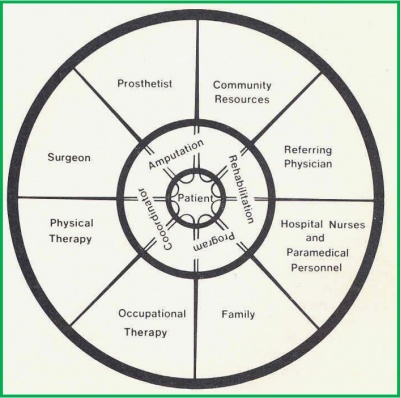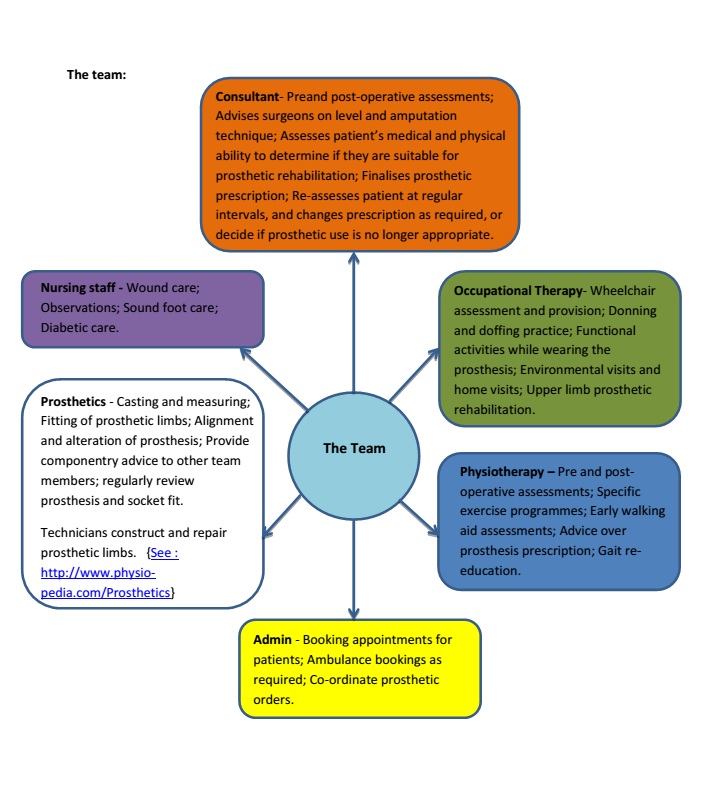Multidisciplinary and Interdisciplinary Management of the Amputee: Difference between revisions
No edit summary |
No edit summary |
||
| Line 36: | Line 36: | ||
*Radiologist / Radiographer | *Radiologist / Radiographer | ||
== Interdisciplinary approach (IDT) <ref>Körner, M. (2010) [http://www.ncbi.nlm.nih.gov/pubmed/20530646 Interprofessional teamwork in medical rehabilition: a comparison of multidisciplinary and interdisciplinary team approach], Clinical Rehabilitation, 24 (8)745-755</ref> == | == Interdisciplinary Team approach (IDT) <ref>Körner, M. (2010) [http://www.ncbi.nlm.nih.gov/pubmed/20530646 Interprofessional teamwork in medical rehabilition: a comparison of multidisciplinary and interdisciplinary team approach], Clinical Rehabilitation, 24 (8)745-755</ref> == | ||
*Professionals involved in joint problem solving, working beyond their own scope of practice. | *Professionals involved in joint problem solving, working beyond their own scope of practice. | ||
Revision as of 19:35, 6 May 2015
Original Editor - Caroline Cater as part of the WCPT Network for Amputee Rehabilitation Project
Top Contributors - Admin, Aicha Benyaich, Sheik Abdul Khadir, Tony Lowe, Richard Benes, Tarina van der Stockt, Kim Jackson, 127.0.0.1, Lauren Lopez, Rachael Lowe, Simisola Ajeyalemi, Amrita Patro and Jess Bell
Introduction[edit | edit source]
For an effective and efficient service for the individual with amputation it is important that the team work together towards goals agreed with the patient. The physiotherapist plays a key role in coordinating patient rehabilitation.
Multidisciplinary team approach [edit | edit source]
The Multidisciplinary Team (MDT) is a team of professionals including representatives of different disciplines who coordinate the contribution of each profession, with little overlap meaning that this term to be used in general for hospital setting. A specialist MDT achieves the best prosthetic outcomes.
- Professionals working parallel with clear roles.
- Each professional sets their own individual goals with the patients and communicates these goals and outcomes with the rest of the team where appropriate.
- Lead by Consultant or team leader.
The MDT is also recognized internationally as the amputee rehabilitation model of choice, although there is little published literature to support this[1]. For amputee rehabilitation the core MDT may include:
- surgeons with different specialties,
- physiotherapist,
- occupational therapist,
- prosthetist,
- counsellor and
- nurse.
The wider MDT team might include:
- Podiatrist
- Diebetologist
- Diabetic nurse
- Dietitian
- Plaster Technician
- Social Care Team
- Discharge Coordinator
- Radiologist / Radiographer
Interdisciplinary Team approach (IDT) [2][edit | edit source]
- Professionals involved in joint problem solving, working beyond their own scope of practice.
- Treatment goals overlap and collaborate with other disciplines.
- Regular communication between team members.
Evidence based clinical guidelines set in 2012 by BACPAR [3] stated: The IDT approach has started to become more prominent in a few areas of the National Health System (NHS) in the UK.This style aims to achieve the optimum outcome for the patients by all professionals working towards the same goals, and working together with other disciplines to problem solve and provide treatment. Korner 2009, compares these two style of working, MDT versus IDT, with a clear outline of how the two approaches differ.Within amputee rehabilitation many limb centres are starting to adopt the IDT approach. As communication between prosthetists, physiotherapists, doctors and other healthcare professionals improve,the team is able to work together more closely and achieve better outcomes.
The Team[edit | edit source]
Care for patients with an amputation traumatic and non-traumatic is complex and requires more multiple medical, surgical and rehabilitation specialties in order to:
- Develop a patient centred treatment plan that includes comprehensive knowledge and best practice for each discipline.
- Reduce the risk of missing potential complications factors that may negatively influence operative and rehabilitation outcomes.
- Enhance patient and family education.
The composition of the team at each phase within the amputee service must be appropriate to the types of service being provided and the needs of the amputee. The patient is to remain at the centre of all decision making and be an integral member of the team that is providing the care. The rehabilitation process should have an educational element that empowers patients and carers to take an active role in their present and future management. The ultimate functional desires and expectations of the patient' needs to be included in the decision making process.
The rehabilitation process
[edit | edit source]
The rehabilitation treatment plan is utilised to guide the care of a patient who has undergone an amputation throughout the entire course of rehabilitation. The treatment plan is based on evaluation by all specialties involved in the rehabilitation process, and acts as a guide for all team members to address goals important to the patient and family. The level of rehabilitation intervention is contemplated from the date of admission to the hospital and determined after the amputation surgery and prior to discharge from the hospital. The rehabilitative process includes:
- Ongoing medical assessment of impairments,
- Therapy interventions to address disabilities or activity limitation,
| Patient Journey | The team management | Physiotherapy management | |
|---|---|---|---|
| 1. | Pre-operative | Subjective assessment - History of present condition; Past medical history; Drug history; Social History.
Objective assessment - Range of movement (ROM); Muscle power; Limb for amputation; Pulses; Skin integrity. Collaborating all findings to decide on most appropriate level of amputation for the individual and, if they are likely to become a limb wearer, which level of amputation would be most appropriate. |
Focus is on the objective assessment looking at ROM and muscle power. Using assessment findings, knowledge of prosthetic componentry and gait patterns, provide a clinically reasoned recommended level of amputation to the consultant. Provide patient with appropriate exercises to aid post-amputation mobility. |
| 2. | Amputation surgery/reconstruction |
Amputation surgery and reconstruction is the responsibility of the surgeon. |
|
| 3. | Acute post-operative |
Medical care; Wound care; Discharge planning; Rigid dressing used rigid material such as plaster of Paris applied immediately after surgery and kept in place for 5-7 and days (only for below knee and below elbow). |
Transfer practice, and specific exercises to improve strength; increase exercise tolerance; maintain ROM. |
| 4. | Pre-prosthetic rehabilitation |
Monitoring patient progress; counselling if required; Patient goals; deciding on prosthetic prescription with whole team and all appropriate information (including how the patient has managed with EWA and patient goals) |
Early walking aids (EWA) can be used to help decide on a patient’s suitability for a prosthetic limb. Exercise therapy to prepare the limb for a prosthesis. Liaison with whole team regarding pre-fitting management of the amputee. |
| 5. | Prosthetic prescription |
Casting and measuring - Prosthetists cast and measure a patient’s residuum. Fitting of the prosthesis - Prosthetists fit the primary prosthesis to the patient, ensuring the alignment and length are correct in a standing and walking. |
Physiotherapist may be needed to assist in the cast appointment, to ensure a neutral alignment of the pelvis is obtained. Physiotherapy provides intervention on mobility guidance, static balance and weight bearing.
|
| 6. | Prosthetic Training |
Prosthetists will help problem solve and adjust prosthesis as required. |
A gait rehabilitation programme can then commence. |
| 7 | Discharge Management |
The occupational therapists take a large trole in this phase to aid the resumption of roles in family, recreational and community activities. They will also assist with vocational rehabilitation by assessing and planning vocational activities for future. May need further education, training or job modification. Counsellers will be involved with emotional equilibrium and healthy coping strategies. |
The physiotherapist should ensure that they include education for ongoing mangaement, strategies for coping and specific training for resumption of functional activities. |
| 8. | Follow up |
Patient will be reviewed regularly by the consultant the physiotherapist, and the prosthetic team. Assessing the individual is still suitable for prosthetic use, the prosthetic prescription is still the most appropriate option for the patient and any required changes are made to the prosthesis as the patient changes. |
The consultant and/or prosthetist may ask for physiotherapy input. For example if the patient is having a change of prescription, their goals have changed, their mobility has decreased/increased. The physiotherapist may be required to re-commence a gait rehabilitation programme with the patient or advice only may be required. |
Mechanisms and importance of communication systems between services
[edit | edit source]
Communication within the IDT is critical and should regularly occur to ensure that the members of the team are informed and aware of a patient’s progress. This is most commonly achieved by a goal setting meeting.This may be held fortnightly or monthly depending on the limb centre and their service. This meeting allows the team to discuss patient goals (which have been clearly defined in the outcome measure COPM) enabling the team to decide on patient focused SMART goals.
Additionally the regular meeting ensures that all team members are aware and up to date with patient progress and any issues or concerns can be discussed with a joint approach to problem solving.
Alternatively an email system may be set up, which can be particularly useful for satellite clinics at different hospital sites. This can be set up as a generic email within the nhs mail system, and works well if all team members are check it regularly and respond in a timely manner.
Telephone contact is also a very useful option to connect members of staff at different sites, and again is particularly useful for team members at satellite clinics to liaise and problem solve with the wider team.
Resources[edit | edit source]
Model of Amputee Rehabilitation in South Australia. Government of South Australia, Statewide Rehabilitation Clinical Network. 2012
Clinical Practice Guideline for Rehabilitation of Lower Limb Amputation. Department of Veterans Affairs, Department of Defense. 2007
References[edit | edit source]
- ↑ Penny Broomhead, Diana DAwes, Amanda Hancock, Pragna Unia, Anne Blundell, Vanessa Davies. Clinical guidelines for the pre and post operative physiotherapy management of adults with lower limb amputation. BACPAR, 2006.
- ↑ Körner, M. (2010) Interprofessional teamwork in medical rehabilition: a comparison of multidisciplinary and interdisciplinary team approach, Clinical Rehabilitation, 24 (8)745-755
- ↑ Broomhead, P., Clark, K., Dawes, D., Hale, C., Lambert, A., Quinlivan, D., Randell, T., Shepherd, R., Withpetersen, J. (2012) Evidence Based Clinical Guidelines for the Managements of Adults with Lower Limb Prostheses, 2nd Edition,Chartered Society of Physiotherapy: London








